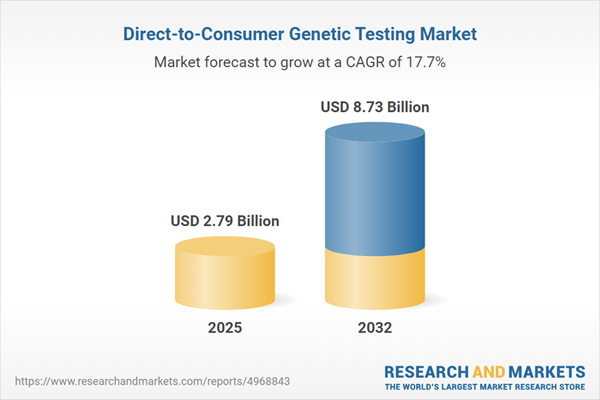Speak directly to the analyst to clarify any post sales queries you may have.
The direct-to-consumer genetic testing market is undergoing rapid transformation, driven by technological advancement, new regulatory dynamics, and changing consumer expectations. Senior leaders must navigate this evolving landscape by understanding underlying drivers influencing strategic positioning, operational resilience, and growth opportunities.
Market Snapshot: Direct-to-Consumer Genetic Testing Market Growth
The direct-to-consumer genetic testing market grew from USD 2.36 billion in 2024 to USD 2.79 billion in 2025. It is forecasted to expand at a strong CAGR of 17.70%, reaching USD 8.73 billion by 2032. Continuous advances in sequencing technologies, heightened consumer interest in personalized healthcare, and expanded digital integration are propelling market expansion. The sector’s evolution unlocks new value for precision health solutions and tailors offerings to rising demand for actionable wellness insights.
Scope & Segmentation
This report provides an in-depth examination and forward outlook for the direct-to-consumer genetic testing space, capturing the spectrum of technologies, applications, and regional drivers. Market segmentation includes:
- Ancestry Testing: Autosomal, mitochondrial, and Y-chromosome analysis for heritage understanding.
- Health Risk Testing: Monogenic and polygenic disease risk assessment, including carrier screening, single gene, and combined factor profiling for cardiovascular and oncology outcomes.
- Trait Testing: Behavioral, physical, and wellness traits such as sleep patterns, stress response, eye color, hair color, caffeine metabolism, and vitamin absorption.
- Nutritional and Fitness Testing: Includes fitness optimization through endurance and muscle performance assessment, as well as mineral and vitamin deficiency screening.
- Pharmacogenomic Testing: Drug response profiling for cardiovascular, oncology, and psychiatric drugs—spanning antidepressant and antipsychotic therapies.
- Paternity Testing: Postnatal and prenatal evaluation for key life decisions.
Geographically, the research covers the Americas (including the United States, Canada, Brazil, and others), Europe, Middle East & Africa (notably the United Kingdom, Germany, France, UAE, South Africa), and Asia-Pacific (including China, India, Japan, Australia, and additional markets).
Technological focus areas include next-generation sequencing, AI-driven data analytics, secure cloud infrastructure, encryption, and blockchain-enabled data governance.
Key Takeaways
- Technological integration is pushing the limits of genomic interpretation, enabling providers to offer richer consumer insights across various wellness and health domains.
- Strategic partnerships between testing firms, digital health platforms, and pharmaceutical companies are critical for delivering seamless user experiences and validating scientific rigor.
- Regional customization, supported by local regulatory engagement and targeted product offerings, is essential to unlock growth in diverse and emerging markets.
- With consumers actively seeking robust privacy and transparent reporting, data protection measures and compliance frameworks have become non-negotiable for industry credibility.
- Stakeholders that invest in consumer education and digital enablement position themselves to enhance adoption, loyalty, and market share in a competitive landscape.
Tariff Impact: United States 2025 Regulatory and Supply Chain Dynamics
The implementation of targeted tariffs by the United States in 2025 has reshaped cost structure and operational strategies in the genetic testing industry. Companies are actively localizing key manufacturing and diversifying suppliers to reduce exposure to trade volatility. Adoption of dynamic pricing models and new service tiers has supported cost management while sustaining broad consumer access. These shifts highlight the increasing importance of supply chain resilience and proactive regulatory engagement for maintaining competitive positioning in the evolving global environment.
Methodology & Data Sources
Findings in this report are derived from in-depth interviews with stakeholders across genetic testing companies, healthcare professionals, regulators, and consumer groups. Primary insights are supported by structured surveys and secondary data sourced from industry databases, scientific literature, and market reports. Cross-validation, double-data entry, and peer expert review underpin analytical accuracy throughout the research process.
Why This Report Matters
- Enables executive teams to calibrate strategic priorities through real-world examples of leadership, innovation, and resilience in the direct-to-consumer genetic testing market.
- Supports product, partnership, and channel decisions by offering clear segmentation and actionable insight on regional and regulatory drivers.
- Provides a validated foundation for investment, portfolio expansion, and operational realignment in response to shifting technological and political dynamics.
Conclusion
This report equips industry decision-makers to navigate complexity and lead strategically in direct-to-consumer genetic testing. By synthesizing robust data, segmentation factors, and global trends, stakeholders can make informed decisions for sustainable, technology-driven growth.
Additional Product Information:
- Purchase of this report includes 1 year online access with quarterly updates.
- This report can be updated on request. Please contact our Customer Experience team using the Ask a Question widget on our website.
Table of Contents
3. Executive Summary
4. Market Overview
7. Cumulative Impact of Artificial Intelligence 2025
Table Information
| Report Attribute | Details |
|---|---|
| No. of Pages | 192 |
| Published | November 2025 |
| Forecast Period | 2025 - 2032 |
| Estimated Market Value ( USD | $ 2.79 Billion |
| Forecasted Market Value ( USD | $ 8.73 Billion |
| Compound Annual Growth Rate | 17.7% |
| Regions Covered | Global |
| No. of Companies Mentioned | 11 |









